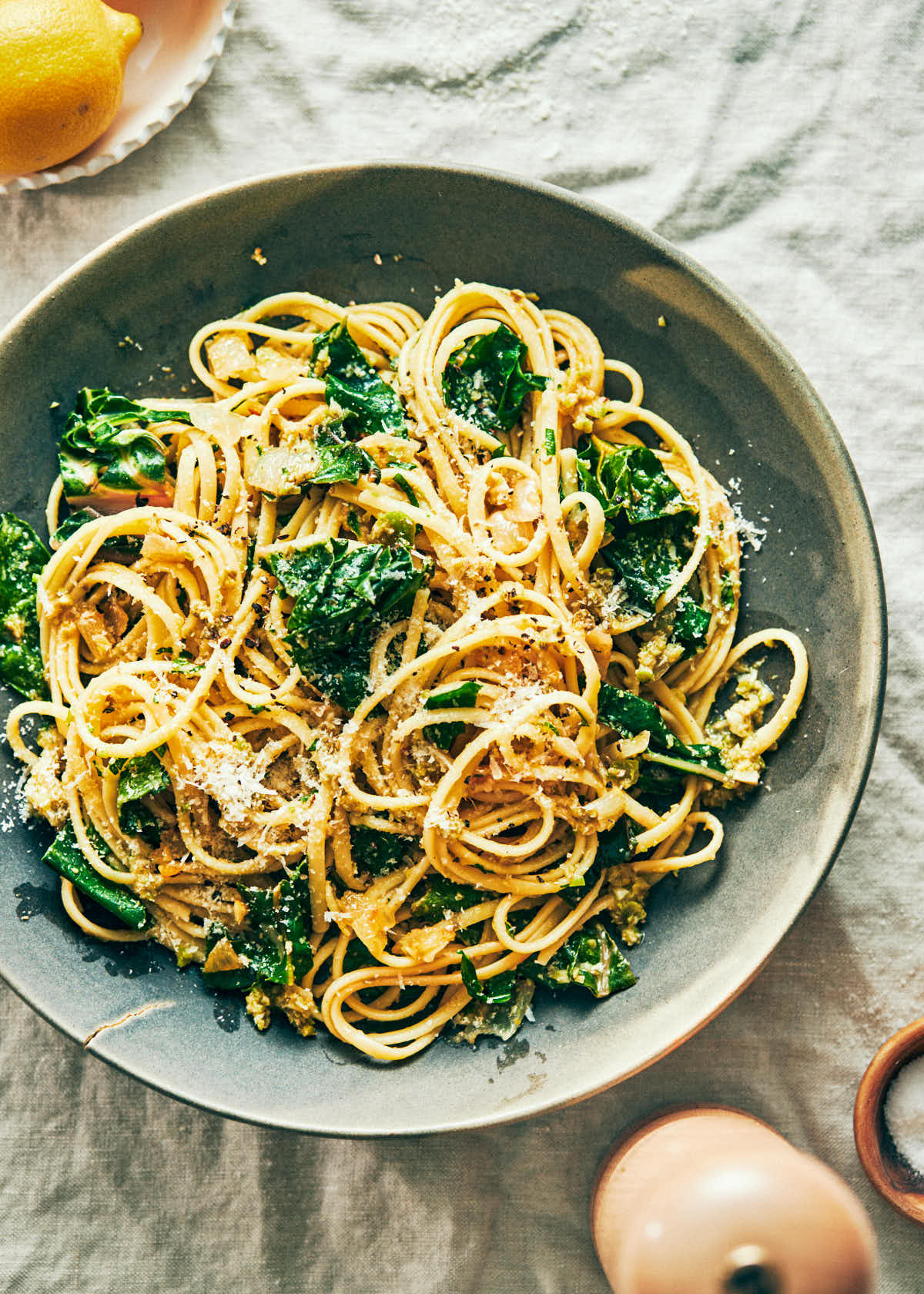
This mouthwatering Lemon Swiss Chard Pasta is one of the most popular recipes on the blog. And for good reason! It features an easy umami-packed sauce made from green olives, capers, lemon, and garlicky olive oil. The flavor combo is bright, fresh, and bursting with flavor.
The finished pasta definitely screams "garlic" and lemon", rather than "olives" and capers". But don't be fooled because olives and capers really make this dish special. Make sure to shower the pasta with cheese at the end, because pasta's always better with cheese.
Jump to:
Why you'll love this recipe
- Flavor packed: This delicious, restaurant-quality pasta is sure to impress. This recipe uses umami rich ingredients to add flavor with minimal effort. The capers and olive sauce melds into the noodles, adding the perfect balance of flavor and acidity.
- Weeknight friendly: This recipe takes just 25 minutes to make. And, leftovers keep well. So it's perfect for delicious weeknight dinners.
- Light and fresh: This recipes uses pasta water and a bit of butter to emulsify the lemon sauce. It doesn't use any cream, so the end result tastes surprisingly light.
- Perfect spring and summer pasta: This pasta is a great way to use up a whole bunch of Swiss Chard! The bright flavors are perfect for spring and summer months. But you can keep enjoying this dish through the fall since Swiss Chard's still in-season.
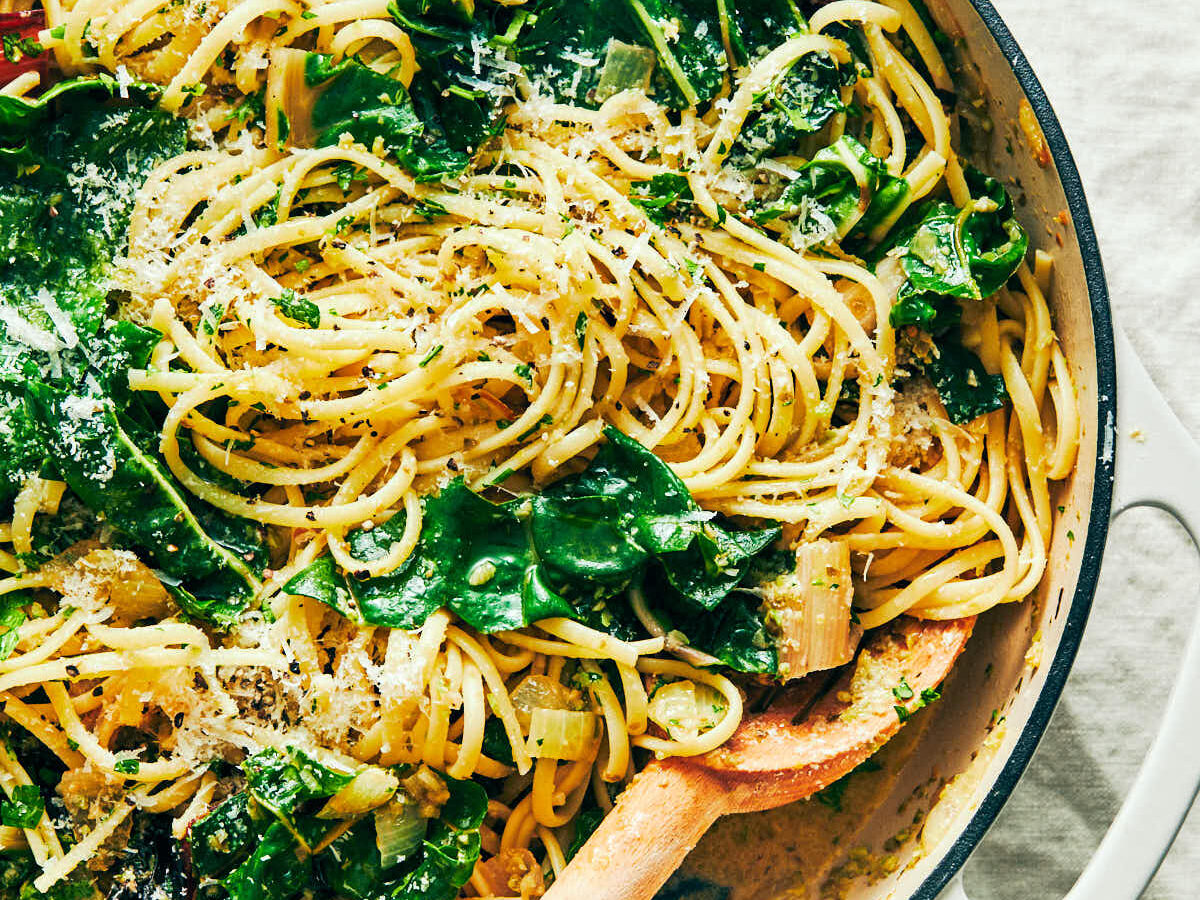

Ingredients (and substitutes)
This Lemon Swiss Chard Pasta is one of our favorite "pantry pastas". It leans heavily on jars and basic pantry items—like garlic, onion, red pepper flakes, capers, and pasta noodles.
Here's what you need to make this recipe:
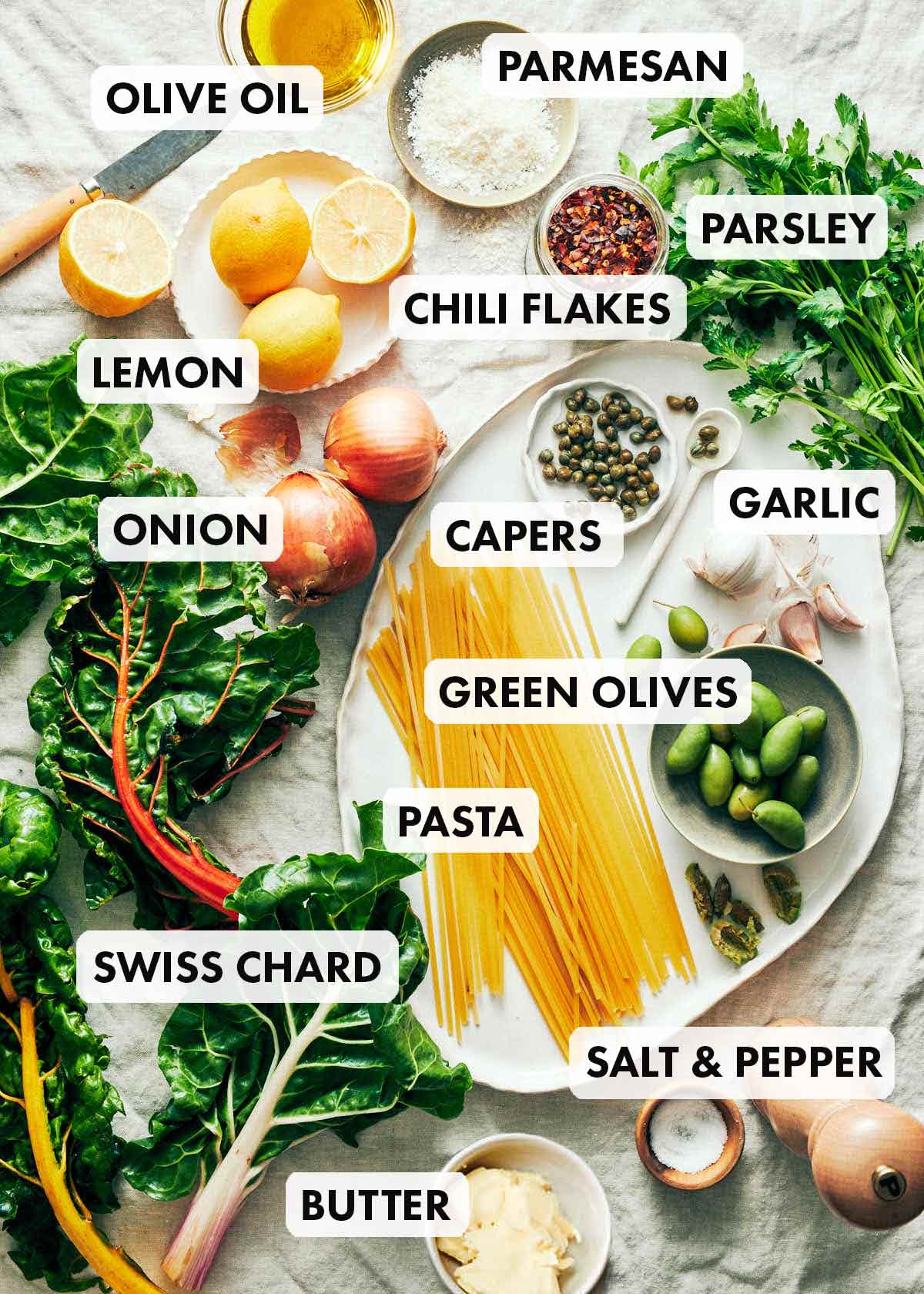
- Pasta: This recipe calls for dried linguine noodles. But other long noodles work too—like spaghetti, fettuccine, or tagliatelle.
- Swiss Chard: You can use any type of Swiss Chard (such as green, rainbow or red). Or, substitute another sturdy leafy green like kale. Some readers have happily used spinach instead.
- Green Olives: I usually use Cerignola olives for this pasta. But other types of green olives work too. Just don't use olives that have been pre-stuffed with cheese, peppers, or other ingredients. Measure out the olives after remove their pits.
- Capers: This pasta uses both capers and the brine that they're packed in. It adds bright, salty flavor to the dish.
- Lemon: Fresh lemon is a must-have for this recipe! It's easier to zest the lemon first, then juice it.
Find the recipe card below for the complete recipe, including all ingredients and instructions.

How to make (step-by-step photos)
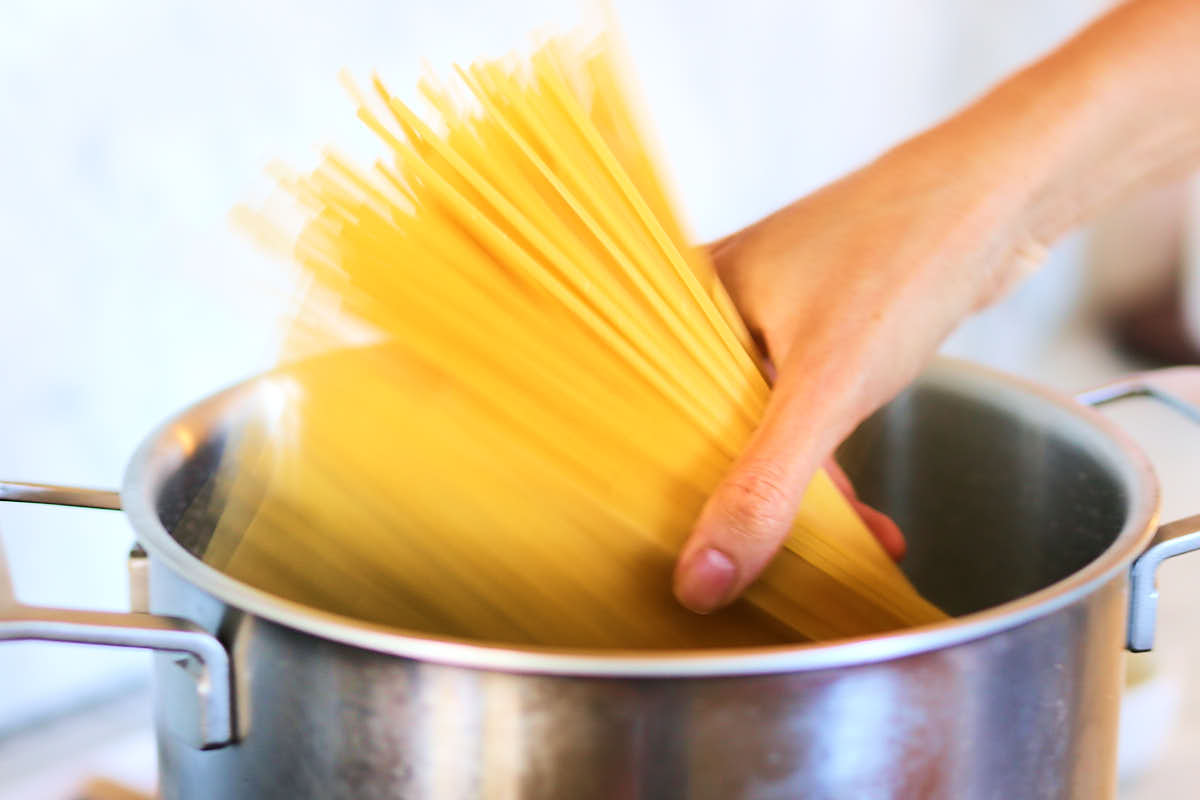
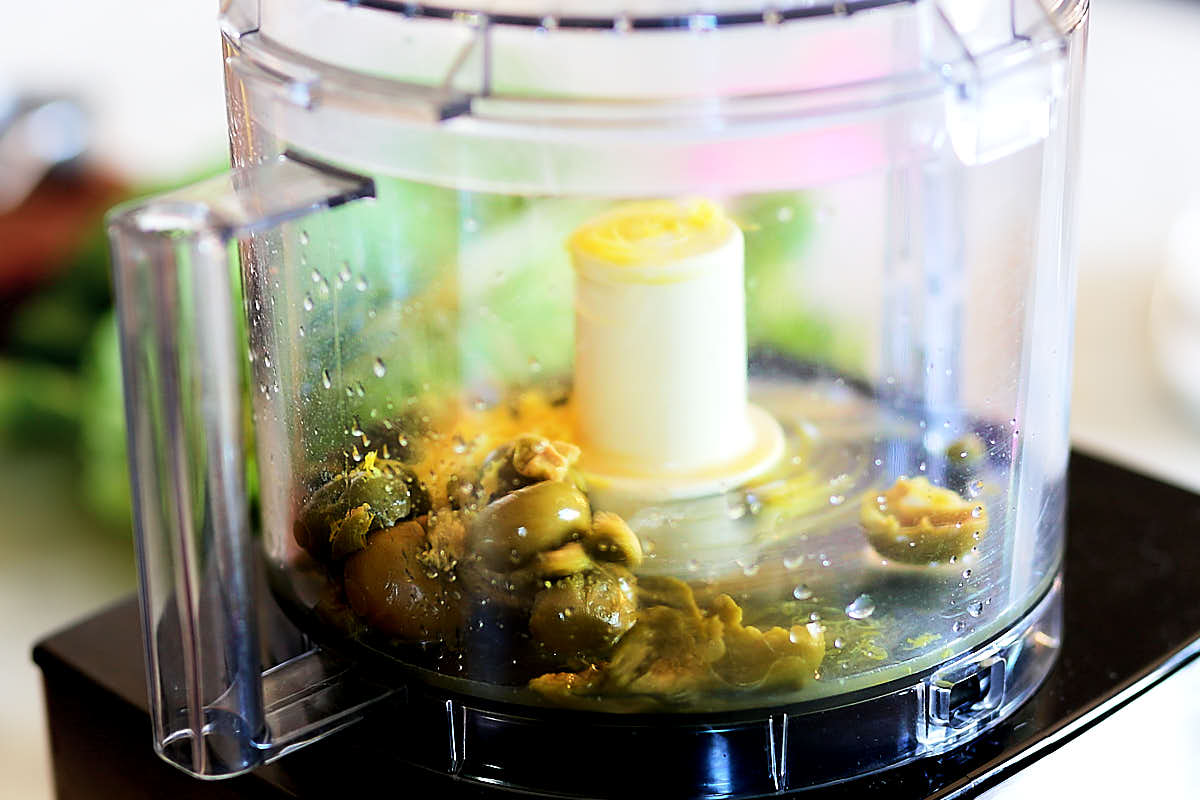

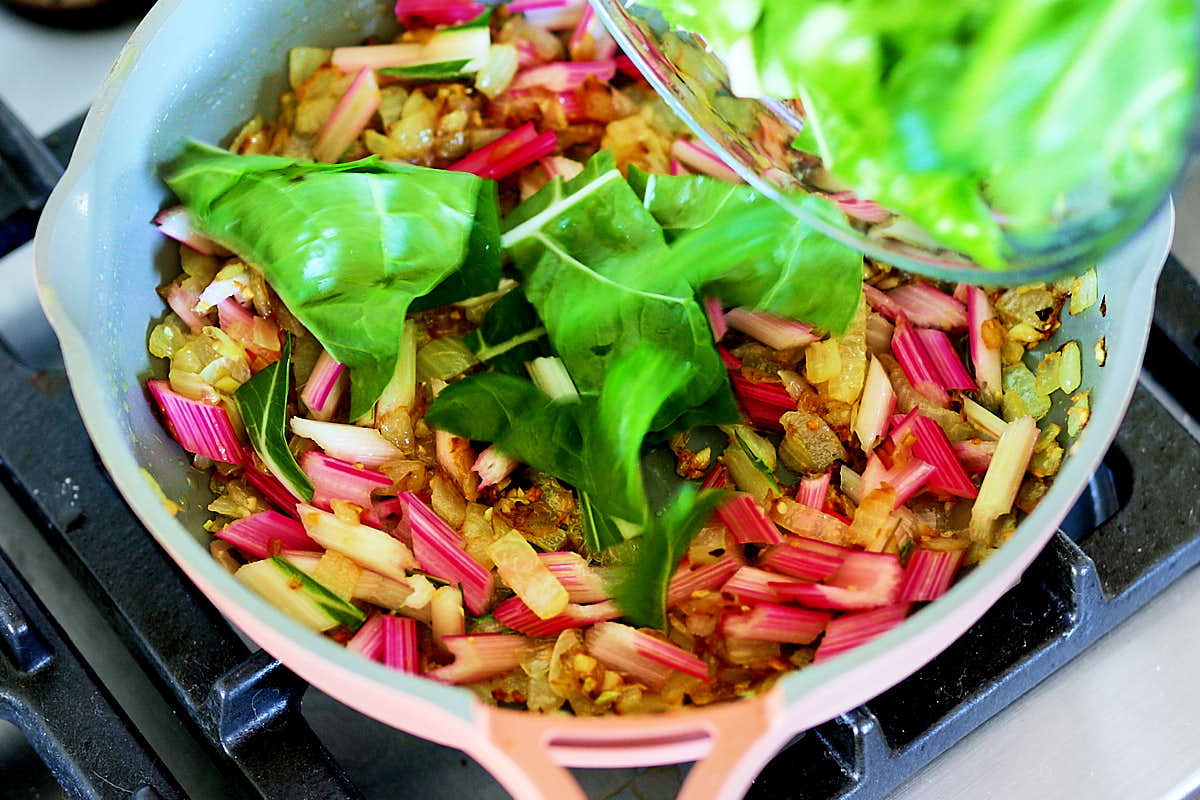
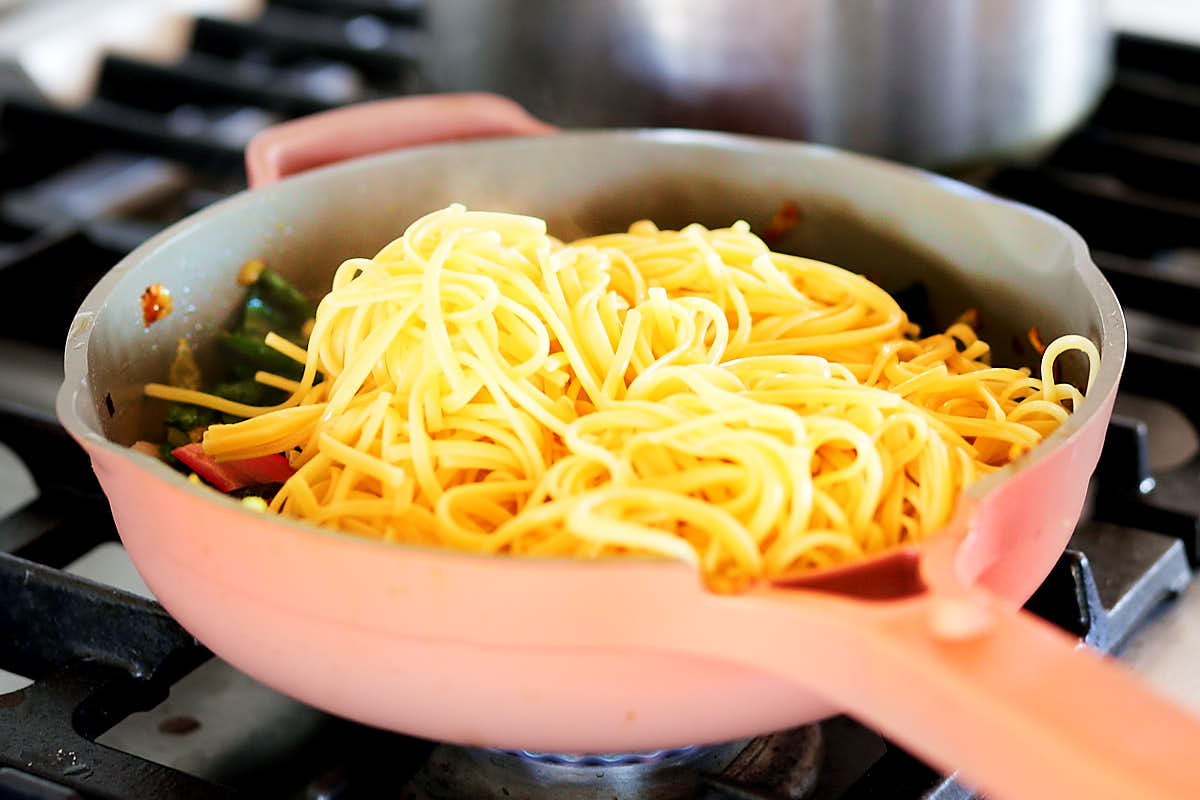
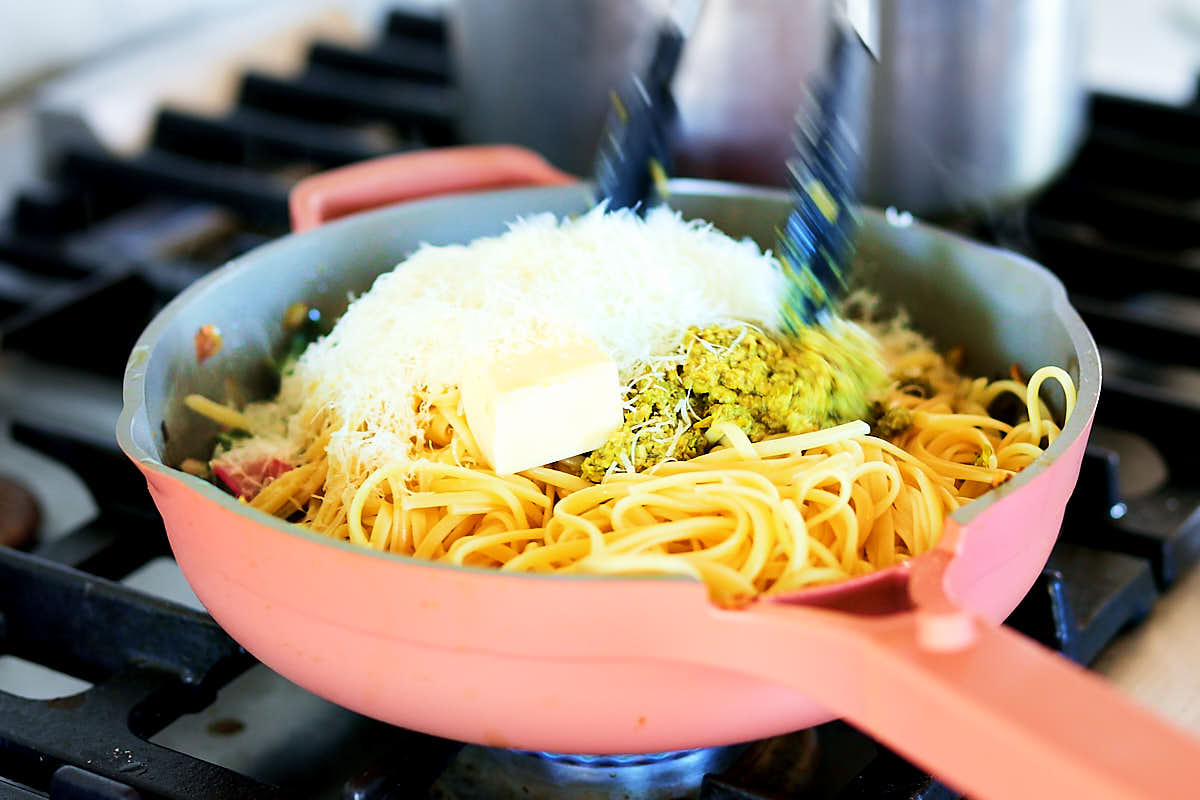
Find the recipe card below for the complete recipe, including all ingredients and instructions.
Tips
- Whole olives have the best flavor/texture: Pitted olives are convenient. But they don't have as good taste or texture. Because once olives are pitted, there's a lot more surface area exposed to the brine they're packed in. So, pitted olives can be softer/mushier—and likely saltier too. In a pinch, you can definitely use them. But whole olives have noticeably better taste and texture.
- How to pit olives at home: It's super simple to remove olive pits at home. All you have to do is scatter the olives on a cutting board. Then, use the flat side of your knife to gently press down on them. The olives will split under the pressure, and then you can pull the pits out with your fingers.
- Getting more juice from lemons: Extract more juice by rolling the lemon on the counter before juicing it (just like in our Hibiscus Lemonade recipe).
- Save your pasta water: The water that your pasta is boiled in is slightly starchy, so it's great for emulsifying sauces. This cooking technique is also great for Mushroom Miso Pasta and Vegan Vodka Sauce Pasta.
- Gluten Free option: Just use gluten free pasta noodles. Some of the best gluten free pastas use a blend of alternative flours (such as corn and rice), for better texture. But use the brand you like best. I usually cook gluten free pasta for less time than listed on the package. This prevents it from getting mushy.
- Vegan option: For the butter, use a vegan butter substitute (such as Miyokos or Earth Balance sticks)...or use more olive oil. Then, use a meltable vegan parmesan cheese substitute—or skip it altogether.
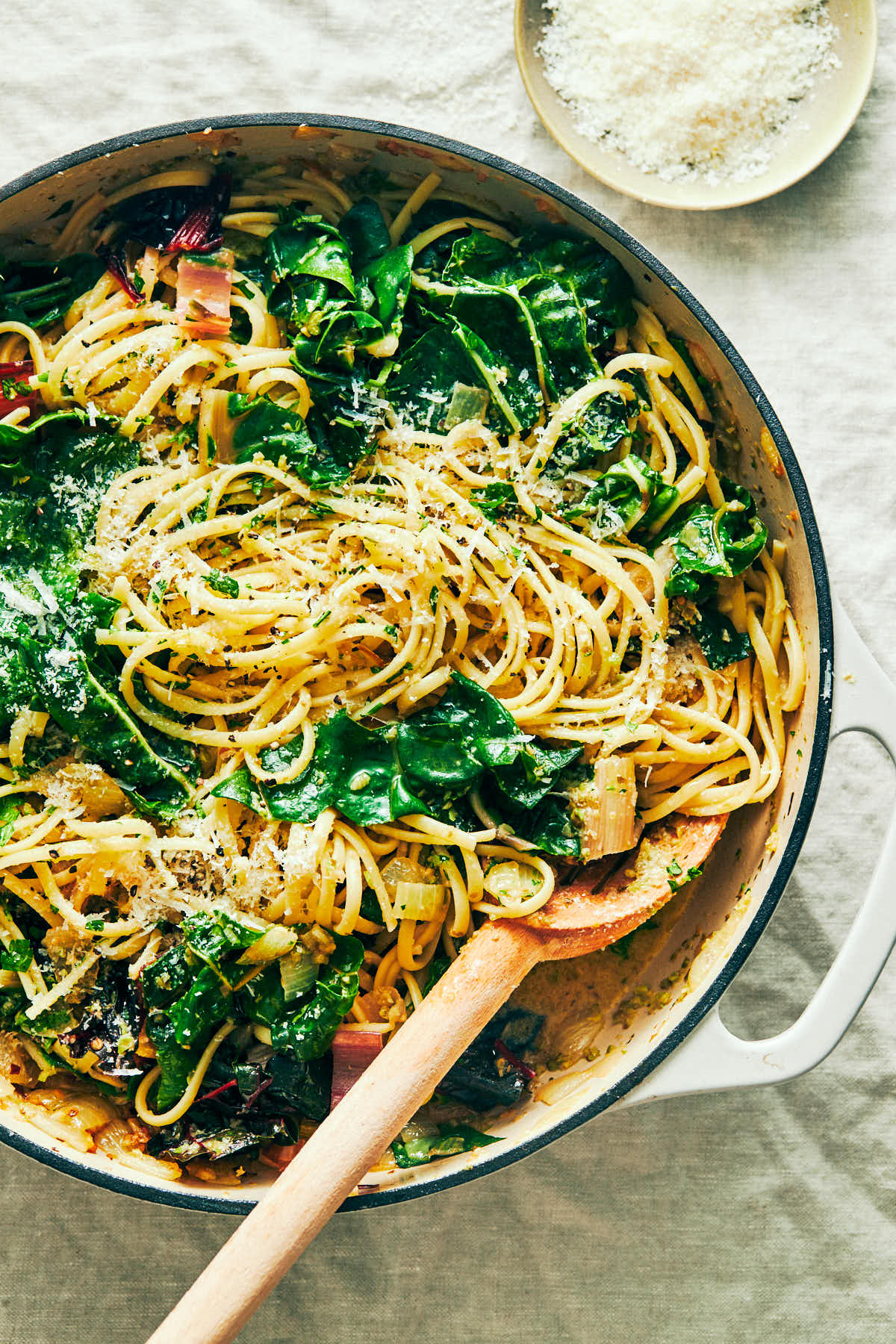
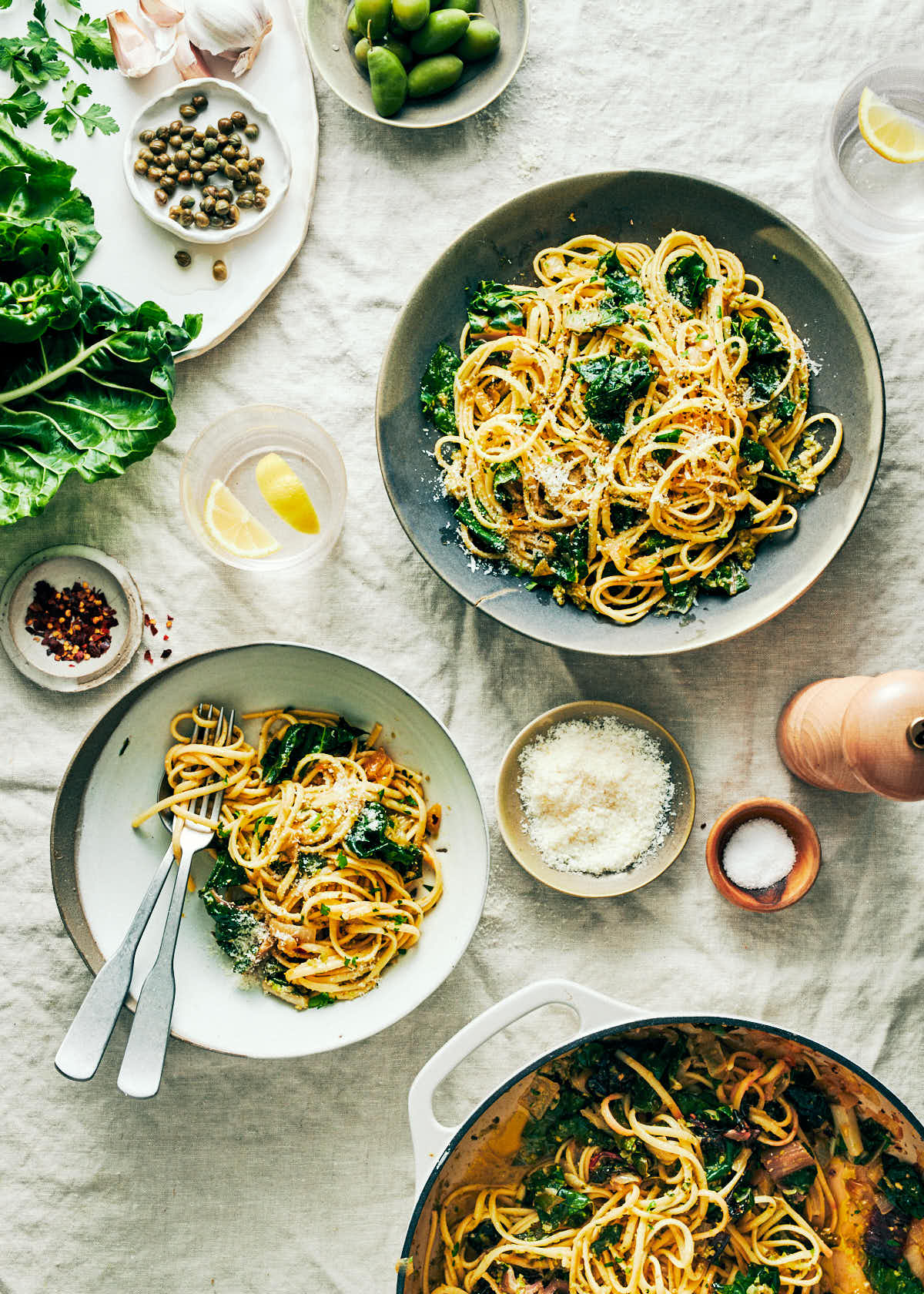
Love this recipe? Please leave a 5-star 🌟🌟🌟🌟🌟 review below!
📖 Recipe
Lemon Swiss Chard Pasta
Ingredients
- 1 lemon
- 10 oz linguine (or spaghetti or fettucini)
- ⅓ cup pitted green olives (see note 1)
- 2 tablespoons capers + 1 teaspoon brine (from jar)
- ⅓ cup extra virgin olive oil
- 1 large diced yellow onion (about 2 cups)
- 5 cloves minced garlic
- ¼ teaspoon red pepper flakes
- 1 bunch chopped Swiss chard (see note 2)
- 1 tablespoon butter (or more olive oil)
- ½ teaspoon fine sea salt
- ½ cup grated Parmesan (more for garnish, see note 3)
- ¼ cup chopped flat-leaf parsley
- black pepper (to taste)
Instructions
- Prep lemon: Zest 1 lemon, removing just the yellow zest (avoid white pith). Then, juice the lemon (you should have about ¼ cup of juice). Set aside.
- Cook pasta: Bring a large pot of salted water to boil. Cook 10 oz linguine until al dente, according to package directions. Reserve 1 cup of pasta water, then drain noodles.
- Mix olives and capers: Meanwhile, to a food processor, add ⅓ cup pitted green olives, 2 tablespoons capers + 1 teaspoon brine, lemon juice and zest. Pulse until a rough paste forms, scraping down the sides as needed.
- Cook sauce: Heat ⅓ cup extra virgin olive oil in a large skillet over medium heat. Cook 1 large diced yellow onion, until very soft and golden brown on the edges, about 10 minutes. Add 5 cloves minced garlic and ¼ teaspoon red pepper flakes. Cook until fragrant, 1 to 2 minutes. Stir in 1 bunch chopped Swiss chard and cook until it begins to wilt, about 2 minutes.
- Combine: Add pasta, 1 tablespoon butter, the olive and caper mixture, and ½ cup of the reserved pasta water. Toss to coat noodles. Sprinkle with ½ teaspoon fine sea salt and ½ cup grated Parmesan , then toss to mix. Slowly drizzle in as much of the remaining ½ cup of the reserved pasta water needed so the noodles are evenly coated with sauce. Sprinkle with ¼ cup chopped flat-leaf parsley. Taste and season with black pepper (and more salt if needed). Garnish with more cheese.
Notes
- Green olives: Such as Cerignola (feel free to use your favorite green olive). We recommend buying whole olives with pits. Whole olives tend to have better flavor and texture. To pit olives at home: Use the flat end of your knife to gently squash whole olives on a cutting board. The olive will split, and you can pull out the pit with your fingers. Measure ⅓ cup of olives after pitting. That said, if you bought pitted olives, those will work too!
- Swiss chard: Can be green, rainbow, or red Swiss chard. The stalks take longer to cook than the leaves, so slice the stalks smaller than the leaves so they cook quickly.
- Parmesan cheese: Imported Parmesan cheese typically contains animal-based rennet. If you wish to avoid this, look for cheese labelled as "vegetarian friendly" or lists "microbial enzymes" as an ingredient (instead of rennet). Asiago cheese is also a good alternative. For a vegan option, use a vegan shredded Parmesan substitute or skip entirely and add more salt (to taste).
- Vegan option: Use a vegan shredded Parmesan substitute. Or in a pinch, skip entirely and add more salt to taste.
- Gluten-Free option: Use gluten-free pasta noodles, making sure not to overcook them (as gf noodles can quickly become mushy).
- Storing leftovers: Refrigerate extra pasta in an airtight container for up to 3 days. I recommend adding a bit more fresh lemon and salt to your leftovers just before eating. This helps to brighten up the flavors again.

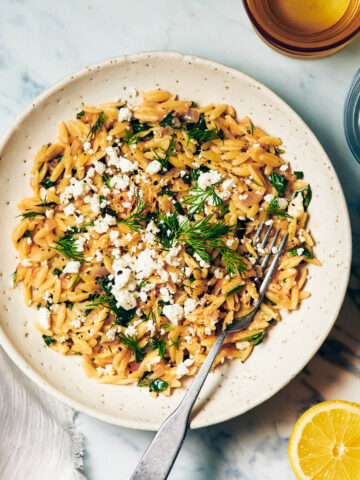
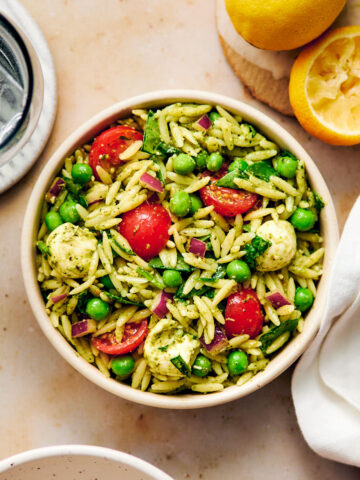
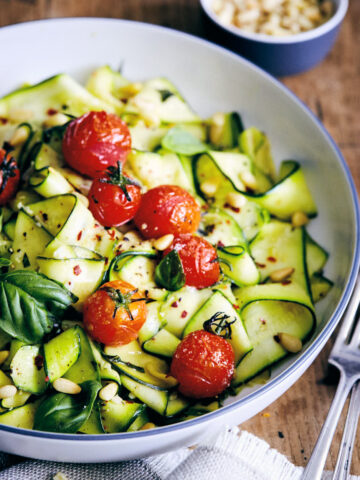
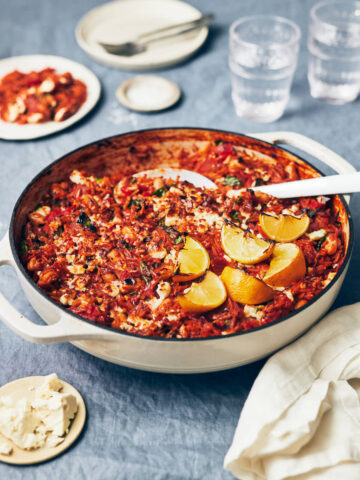

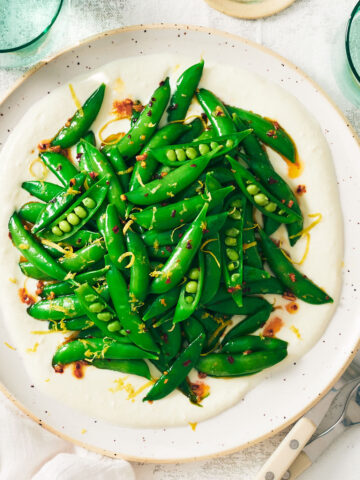
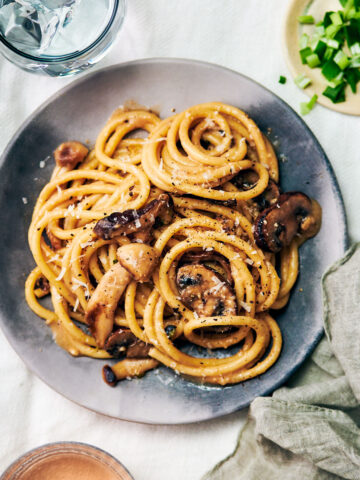
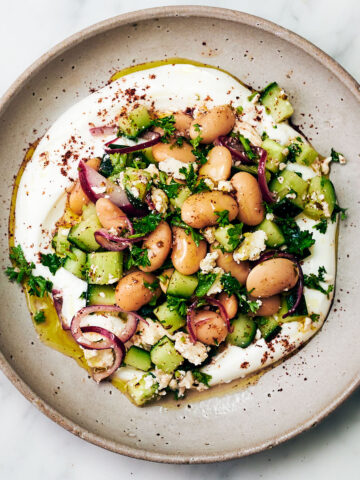

Bea says
I was given a bunch of Swiss chard and didn't know what to do with it. This recipe was a perfect introduction to cooking with chard and I will be adding it to my regular meals!
bri says
Hi Bea! It's Swiss chard season, that's for sure! So glad you enjoyed this recipe. Thanks for taking the time to leave a review!
Barb says
Measure chard in grams pls!
bri says
Hi Barb! A standard store-bought bunch of chard usually weighs 0.75 lb (or 340 g). I wouldn't stress too much about adding the exact weight because it's pretty flexible in this recipe. From the comments you can see that some readers add more, others less, and some swap with another green of choice! Whatever suits your personal preference for cooked greens in hot pasta. Hope this helps and have a great rest of your week!
Lee says
Just love this dish! It’s One of my favourite dishes now. Simple and all ingredients are available without breaking the bank. I grow Swiss chard in my garden and was looking for new recipes wit Swiss chard and this was a hit.
bri says
Hi Lee! So happy to hear you love this Swiss Chard pasta. It's one of my favorites for this time of year! Hope your Swiss Chard garden harvest goes well this year. Have a great weekend ahead:)
lauren says
Needed to use up the Swiss chard we spontaneously bought at the farmers market, I skipped the red pepper flakes because they are usually too spicy for me.
bri says
Hi Lauren! Glad to liked this swiss chard pasta. Thanks for sharing your note about the red pepper flakes:) Happy it worked out.
Phyllis says
This was delicious. Will definitely be making again😊
bri says
Hi Phyllis! So glad you enjoyed this pasta. Thank you for taking the time to share!
Beatrice Birch says
While it took us MUCH longer than the stated 30 minutes to prepare, we enjoyed it thoroughly & will make again. For added nutrition, we used whole wheat pasta, which stood up well to the hearty brininess of this dish. Thanks for a wonderful recipe.
bri says
Hi Beatrice! Thanks for sharing your experience with using whole wheat pasta instead! I haven't tried it that way, so that's super helpful. Appreciate you taking the time to write in. Have a great week ahead!
Hannah R says
Super yummy! My boyfriend and I devoured this pasta last night. Adding it to our rotation:)
bri says
So glad you both loved it! Thanks for sharing, Hannah!
Tia says
Okay, YUM! I have a garden full of chard and was searching for ways to use it. This came across my feed and I took the risk. This recipe is a bit of a stretch for the average American! Capers, green olives, brine, lemon zest, a whole white onion. Wow! The only modification I made to this recipe was the addition of dry rub, BBQ chicken tenderloin. I had a bunch of leftover, so I sliced it up and added it at the end. Yum, yum, yum. Love this meal!
bri says
Hi Tia - So glad to hear you gave this recipe a try and that you enjoyed it! Thank you for taking the time to leave a review, it helps others find our recipes too:) Have a great weekend ahead!
James says
I grew some Swiss chard in my garden and I wanted to use it so I googled ‘Swiss chard pasta recipe’ and after seeing I had all the ingredients already an hour or so later I was serving this up to the family. Four empty plates told it’s own story!
bri says
Hi James! Yay, so glad to hear how you stumbled upon this recipe. And, even better that your family loved it! Hope you're having a great garden harvest. Thanks for choosing to make one of our recipes with your home grown chard:)
Sue says
This looks delicious, I grew up eating Swiss chard my father grew. I just harvested quite a bit of chard. I only wish an ad wasn’t covering part of the recipe. Any suggestions how to remove it from covering part of the recipe?
bri says
Hi Sue! That's so lovely that your father grew Swiss Chard. And, you as well, by the sounds of it. We're really, really sorry that you're having trouble seeing the recipe.That's definitely not supposed to happen! Can you let us know what device you're accessing the recipe on (e.g. cell phone, tablet, laptop)—and we'll look into it. In the meantime, you can hit the "Print Recipe" button, which should give you a nicely formatted, printed recipe card that has all the info you need (no ads). You can do this on any of our recipes. Hope this helps! Thanks so much for flagging this to us.
nancy says
I've been looking for something to do with the swiss chard in our garden and this recipe IS IT. Loved it and will be making it all summer long.
bri says
Hi Nancy - So lovely to hear this! Glad you enjoyed this pasta. Hope you have a great rest of your summer!
Andrea says
Love the green olives and capers in this dish! We've gotten so many compliments making it for friends over the last few months. It's become our go to dinner party dish.
bri says
Hi Andrea! Yay that makes me so happy to hear. Thank you so much for making our recipe for your friends! Hope you're having a great summer so far.